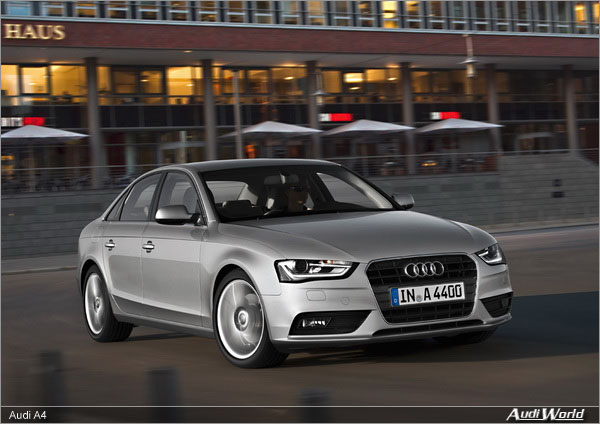November 30, 2011
Source: Audi of America
The new Audi A4
Design and body
– Three versions: Sedan, Avant and allroad quattro, plus two S models
– Three trim lines: Attraction, Ambition and Ambiente
– Harmonious, elegant design with new sporty flourishes
– Xenon plus headlights with LED daytime running lights and LED tail lights as an option
Interior and control
– Further enhanced ergonomics; stylish new materials and colors
– High-tech driver assistance systems, including Audi active lane assist and adaptive cruise control with full brake application below 30 km/h (18.64 mph)
– Driver information system with break recommendation standard on all models
Engines
– Four gasoline and six TDI engines; output from 88 kW (120 hp) to 200 kW (272 hp), an additional V6 with 245 kW (333 hp) for the S models
– New, highly efficient 1.8 TFSI with innovations in numerous areas
– Start-stop system standard; average fuel consumption reduced by 11 percent
– Six-speed manual, multitronic or S tronic – depending on engine version
– quattro permanent all-wheel drive with torque vectoring; sport differential available for models with top engines
Chassis
– Rear trailing arms and shock absorbers retuned
– ESP with electronic limited slip differential standard with front-wheel drive
– New electromechanical power steering with minimal energy consumption
– Audi drive select available with as many as five driving modes
– Large wheels measuring 16 to 19 inches in diameter; powerful brakes
Infotainment systems
– Broad spectrum of modules; optional top-of-the-line MMI navigation plus with a hard drive and refined operating philosophy
– Bluetooth online car phone with a wealth of Audi connect services such as Audi online traffic information and voice-activated Google POI search
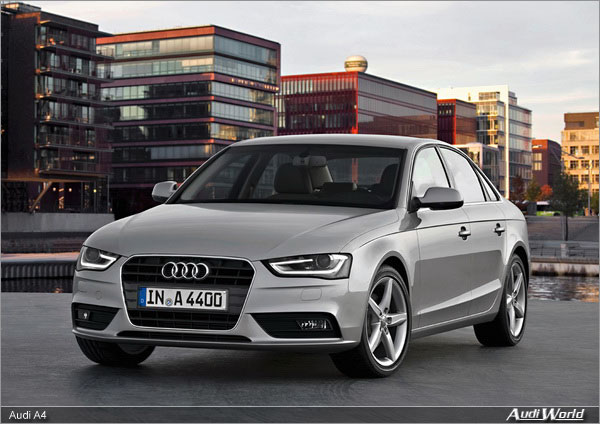
The all new Audi A4 – Exterior Design
All three body variants of the A4 family – the Sedan, the Avant and the allroad quattro – impress with their sporty, elegant exterior design with harmonious proportions, the long engine hood, the short overhangs and the long wheelbase. Sharp lines frame muscularly arched sheet metal surfaces integrating a flat greenhouse.
Many design details are now more striking, and the front end appears even flatter and broader. Sharp edges emphasize the three-dimensional tension of the engine hood. The single-frame grille is platinum gray. In models with a V6 engine or with the S line exterior package, it is a high-gloss black. It has tapered upper corners, and its delicate lateral bars and the Audi rings are sculpted. Horizontal chrome strips convey a unique note to the grille of the A4 allroad quattro.
The new headlights are also immediately recognizable. Their interior has been restructured, the housing is wedge-shaped and their lower edge forms a subtle wave. With the optional xenon plus headlights, the highly efficient LED daytime running lights form a narrow, homogenous clasp that largely follows the outer contour, remaining open in the area of the xenon lens. The turn signals are a strip at the upper edge. Audi also offers the adaptive light system with dynamic cornering light and static turning light.
The newly designed bumpers on all models contain large air inlets that taper inward and are framed by strong edges. They are covered by new grilles, which with the S line and S models feature a diamond pattern. Crossbars in high-gloss black divide the grilles. Rectangular fog lights (round in the A4 allroad quattro) are mounted in the top sections. The flat air inlet below the single-frame grille has also been redesigned.
A4 models equipped with xenon plus headlights also feature rear lights using light-emitting diodes. The turn signal is a horizontal line, and the tail light forms a low, homogenous clasp. The brake light is located beneath the turn signal.
Modifications have also been made to the Audi rings, the bumper and the diffuser insert. Depending on the engine, the standard exhaust system has either two tailpipes on the left side or one tailpipe on the right and the left.
Broad palette: 15 paint colors
The updated A4 models are available in a choice of 15 colors, four of them new. The solid colors are called Brilliant Red, Brilliant Black and Ibis White. The metallic and pearl-effect colors are as follows: Cuvée Silver, metallic; Ice Silver, metallic; Glacier White, metallic; Lava Gray, pearl effect; Moonlight Blue, metallic; Monsoon Grey, metallic; Phantom Black, pearl effect; Scuba Blue, metallic; Teak Brown, metallic; and Volcano Red, metallic. There are two additional options available in combination with the S line sport package: Daytona Gray, pearl effect and Misano Red, pearl effect.
Fans of a dynamic look can order the S line exterior package for the Sedan and the Avant. The package adds specific details to the front and rear bumpers, the high-gloss black single-frame grille, the air inlets, the platinum gray diffuser and the side sill trims, which are painted in the body color.
The door sill trims and the front fenders sport S line badges; chrome-look strips frame the fog lights; and four-cylinder models get attractive tailpipe trims. The S line exterior package adds a roof spoiler to the A4 Avant.
Another option available from Audi for the A4 Sedan and the A4 Avant is the high-gloss package (standard with the Ambiente trim line), with which the window capping strips and the roof frame are made of aluminum. A third alternative is the Audi exclusive black styling package, which bathes the window capping strips and other bolt-on parts in matt black.
Available for the A4 allroad quattro is the aluminum-look exterior, which contrasts large alloy elements such as the roof rails with trim elements in high-gloss black. The flared sills sport stainless steel inlays. The increased ground clearance, the flared fenders and the underbody guards at the front and rear give the A4 allroad quattro a robust overall appearance.
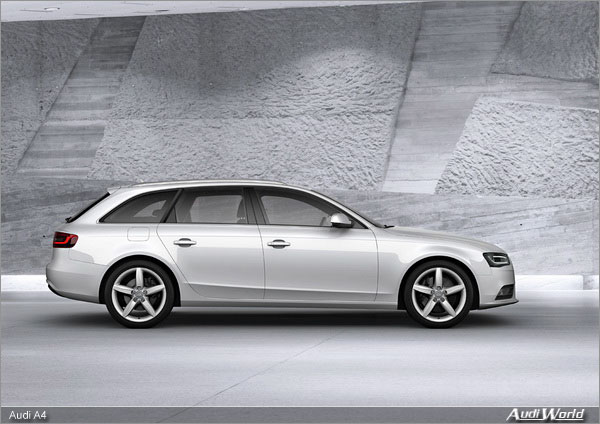 The all new Audi A4 – Body The all new Audi A4 – Body
The Audi A4 is a stately mid-size car. The Sedan and the Avant measure within 2 millimeters (0.08 in) of one another. Both are 4.70 meters (15.42 ft) long; the allroad quattro measures 4.72 meters (15.49 ft). The Sedan and Avant are 1.83 meters (6.0 ft) wide versus 1.84 meters (6.04 ft) for the allroad quattro; height is 1.42 meters (4.66 ft), 1.44 meters (4.72 ft) and 1.50 meters (4.92 ft) for the Sedan, Avant and allroad quattro, respectively.
The body of the A4 showcases a classic Audi strength – the intelligent hybrid construction with high-end materials. The crossmember behind the front bumper, for instance, is made of aluminum. Conventional deep-drawing steel accounts for only 38 percent of the weight of the sedan. High-strength grades account for 32 percent and ultra-high-strength steels for 18 percent. The remaining 12 percent are hot-shaped steels, which get their extreme tensile strength from a dramatic temperature increase during shaping.
Hot-shaped steels account for 34 kilograms (74.96 lb) of the weight of the body-in-white of the Audi A4. Thanks to their relatively low wall thicknesses, they save nine kilograms (19.84 lb). Used at the frontwall crossmember, the center tunnel, the B-pillars and the inside sills, hot-shaped steels form a strong structure in the occupant cell. In a crash, they transfer the forces in such a way that the dissipation of energy poses the least possible risk to the occupants.
Audi uses a special structural adhesive in many areas to assemble the body. 95 meters (312 ft) of bonded seams overall further enhance the rigidity of the joint. In the doors and at the sills, another high-end technology is used: remote laser welding. An invisible seam produced by plasma brazing joins the side of the car to the roof. This seam is extremely precise and thus virtually invisible, so that the A4 does not need roof trim strips.
The low weight of the body is the foundation of the ultra-lightweight construction concept of the A4. Equipped with the 1.8 TFSI, the Sedan has a curb weight (without driver) of just 1,430 kg (3,152.61 lb). The body also achieves excellent values for rigidity, vibrational comfort and crash safety.
The restraint systems of the A4 are precisely coordinated with the deformation properties of the sheet metal. When activated in the event of a crash, the retention system considers the seating position of the driver and front passenger so that persons of all sizes are well protected. The system also includes standard side airbags in the front (optional in the rear) and head airbags.
The integral head restraint system diminishes the risk of whiplash in the event of a rear-end collision by supporting the upper body parts and heads of front-seat passengers. And the seatbelt tensioners ensure that passengers remain safely seated during a severe rear-end collision. ISOFIX child-seat anchors are standard for the rear seats and optionally available for the front-passenger seat.
The base version of the updated A4 Sedan has a front surface area of 2.20 m2 (23.68 sq ft). Its coefficient of drag is just 0.27 – a result due in part to the underbody, which is largely covered with plastic panels. The engine compartment has been specifically optimized for low-turbulence flow.
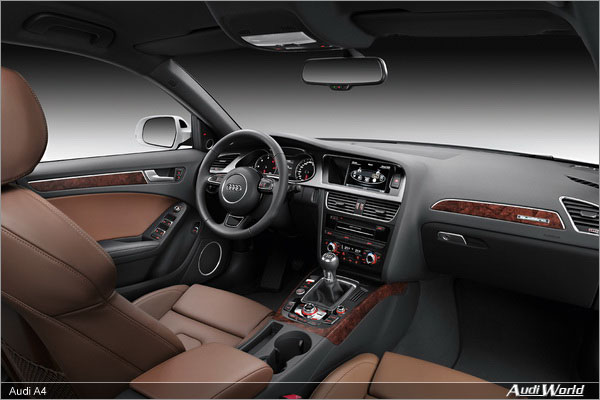 The all new Audi A4 – Interior The all new Audi A4 – Interior
Perfect functionality and generous amounts of space – the interior of the A4 models is now sportier, with flowing lines and an open, elegant and clean look. The uncompromising Audi quality philosophy is reflected in the choice of materials and how they are used.
The front seats, both of which are height-adjustable, provide excellent hold and support. Options include power adjustment, power-adjustable lumbar support, a memory function for the driver’s seat, heated seats – including for the outer rear seats – and a sliding front center armrest with storage compartment. Passengers in all five of the easily accessible seats have ample head, shoulder, leg and footroom.
Three individual variants complete the range. The sport seats (standard with the Ambition line) have large side bolsters, a power-adjustable lumbar support and an extendable thigh rest. With the S line sport package, Audi offers optional S sport seats with integrated head restraints. Small fans provide ventilation to the luxuriously upholstered climate-controlled comfort seats; automatic heating guards against excessive cooling.
Cup holders and storage compartments are provided in the door pockets, the center console and the folding rear armrest. Audi offers optional storage nets for the backs of the front seats, cup holders for the rear seats and a storage package. Its most important elements are two seat nets and two storage bins beneath the front seats.
New compositions: colors and materials
The interior has been tweaked once again as part of the A4 family update. The new, one-piece fascia of the instrument cluster comes standard with a high-quality gray finish. The fascia on the center console around the air conditioning and radio is painted high-gloss black.
The Attraction trim line includes inlays in Steel Gray Reflex Paint; Moor Brown is available with Ambition. Audi also offers a number of special materials as options: Aluminum Trigon (standard with the Ambiente trim line) and the woods Walnut Dark Brown and Fine Grain Ash Natural Brown. Beaufort Oak layered wood veneer is particularly eye-catching.
The Audi interior designers have also remixed the color palette. With the exception of black, nearly all colors for the headlining, carpeting, instrument panel, door trims and upholstery are new. The following colors are available (depending on model): Gray, Chestnut Brown, Lunar Silver, Moor Brown, Pashmina Beige, Velvet Beige, Black and Titanium Gray.
Cloth upholstery is standard for the seats. Audi offers two grades of leather as options: Milano and Fine Nappa. The latter is part of the Audi exclusive range and replaces Valcona. With these options, the door armrests are also covered in leather. Leather packages and arrangements from the Audi exclusive range round out the upholstery lineup.
Another option is the S line sport package. Available for the Sedan and the Avant with the Ambition trim line, it lends the interior a cool black look. Contrasting gray stitching accentuates the sport seats, the floor mats, the leather sport steering wheel and the shift or selector lever. The inlays are in Matt Brushed Aluminum. The S line sport suspension, which lowers the vehicle body by 30 millimeters (1.18 in), and 18-inch wheels as well as S line badges on the body and on the door sill trims round out the package, which can be combined with many more options.
The Audi exclusive range includes further customization options for colors, materials and control elements. Particularly attractive is the stylishly composed Audi exclusive line with two-tone upholstery in Alabaster White, Cognac and Cloudy Gray. This option can now also be combined with the S line sport package.
Even easier: operation
Operation of the A4 has become easier. The ignition key, the steering column stalk and the three-spoke leather sport steering wheels have been redesigned and now include chrome and high-gloss inlays. Options include a steering wheel with a flat-bottomed rim, shift paddles for the automatic transmission on the steering wheel and new multifunction buttons that follow an intuitively comprehensible logic. The mute and navigation information functions are new here.
The air conditioning and infotainment controls have fine chrome clasps. The same is true for the power window buttons, the air vents and the switches for the power seats. Buttons allow you to switch among three settings for the optional seat heating and seat ventilation systems; the center console’s displays are illuminated in white throughout.
The automatic transmission is operated using a new selector lever. It is now easier to switch into S mode – a single press is all it takes. And just one button now suffices for controlling the optional Audi drive select. Operation of the highly efficient automatic air conditioning system has also been tweaked, and the three-zone deluxe automatic air conditioning system features a new particulate filter with a finer fleece.
Versatile: the cargo areas
All three body versions in the A4 family have large cargo areas. The Sedan has a luggage capacity of 480 liters (16.95 cu ft), whereas the Avant and the A4 allroad quattro each offer 490 liters (17.30 cu ft). There is no difference between front-wheel drive and quattro models. The low loading lip and the straight side walls make it very easy to utilize this space.
The split rear seat backs standard in all models can be folded down in just two steps. The head rests do not have to be removed. This increases the cargo volume to 962 and 1,430 liters (33.97 and 50.50 cu ft), respectively. The tie-down rings are made of solid metal and chrome-plated.
The tailgate of the Audi A4 Avant and the A4 allroad quattro opens high enough that even tall persons can stand beneath it. The partition safety net and the cargo area cover, which slides upward with a gentle push, are stored in separate cartridges. Roof rails and a reversible cargo floor are standard in both models. As with the Sedan, a load-through hatch with a ski and snowboard sack is available as an option.
Audi offers a number of additional practical features as options for the A4 Avant and the A4 allroad quattro – a reversible mat, an electromechanical drive for the tailgate and the cargo area package. The cargo area can be flexibly divided using the latter’s rails, telescoping rod and belt. The trailer hitch and racks for bikes, snowboards and skis are designed for the sporty, active customers of both models.
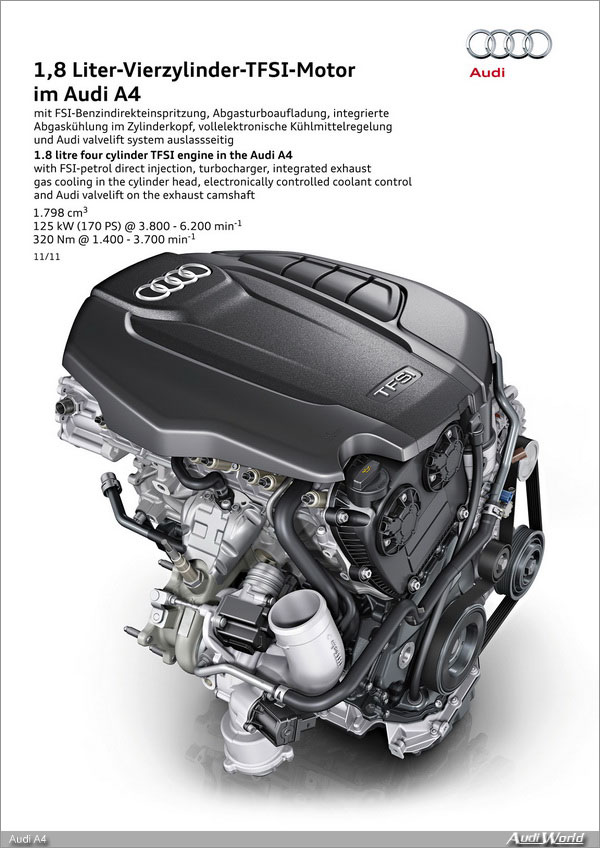 The all new Audi A4 – Engines The all new Audi A4 – Engines
The engines used in the A4 model series – four TFSI gasoline and six TDI units – combine sportiness and efficiency in a groundbreaking manner. All engines follow Audi’s downsizing principle. They feature forced induction and direct injection for tremendous pulling power. Even the entry-level four-cylinder engine produces 230 Nm (169.64 lb-ft) of torque. The start-stop system is standard for all models. CO2 emissions have decreased by 11 percent on average across the board, with the individual reductions as high as 19 percent. At the same time, performance has increased with many of the engines.
Thoroughly redesigned: the 1.8 TFSI
Even the lowest-displacement engine in the lineup, the 1.8 TFSI, demonstrates Audi’s engine expertise to the full. Audi development engineers have thoroughly enhanced the four-cylinder unit and created new solutions regarding numerous aspects of engineering. The results are powerful performance and astonishingly low fuel consumption. The high-end four-cylinder unit has a torque curve similar to that of a TDI. Maximum torque of 320 Nm (236.02 lb-ft) is available at just 1,400 rpm and remains constant up to 3,700 rpm. Maximum output of 125 kW (170 hp) is achieved at just 3,800 rpm.
The 1.8 TFSI accelerates the Audi A4 Sedan from zero to 100 km/h (62.14 mph) in 8.1 seconds on its way to a top speed of 230 km/h (142.92 mph). Yet it requires just 5.7 liters of fuel per 100 km (41.27 US mpg) on average – a CO2 equivalent of 134 grams per km (215.65 g/mile). Consumption has been reduced by a full 18 percent compared with the previous-model engine that produced 118 kW (160 hp).
A major innovation in the 1.8 TFSI is the addition of indirect fuel injection. Complementing FSI direct fuel injection, it is active at part load, where it reduces fuel consumption and particulate emissions. FSI direct fuel injection comes into play when starting and at higher loads. The Audi engineers achieved new degrees of freedom when it comes to charging efficiency in the combustion chambers. Both camshafts can be adjusted as needed, plus the Audi valvelift system adjusts the lift of the valves on the exhaust side to minimize gas exchange losses.
The innovative thermal management system features a further innovation: Two rotating cores control the flow of coolant. These valves ensure that the engine oil heats up to its operating temperature soon after the vehicle is started; they also maintain the coolant temperature, as per a given driving situation, between 85 and 107 degrees Celsius (185.0° F and 224.6° F). As a result – regardless of load or engine speed – the valves always strike the perfect balance between minimal friction and high thermodynamic efficiency.
The exhaust manifold of the compact four-cylinder unit is integrated into the cylinder head, where it is bathed in water. This solution reduces the exhaust gas temperature. The turbocharger is also a new development. Its most important innovation is an electric wastegate actuator that adjusts the boost pressure particularly quickly and precisely, optimizing engine response.
Despite all the new technologies and the added performance, Audi has reduced the weight of the 1.8 TFSI from 135 to 131.5 kilograms (297.62 lb to 289.91 lb). Internal friction has also been significantly reduced by the use of an innovative coating on the piston skirts and by mounting the two balance shafts that provide for smooth operation in roller bearings.
The regulated oil pump requires little energy itself, and a high-precision electric system controls the piston heads with jets of oil.
The TFSI: from 88 kW (120 hp) to 200 kW (272 hp)
The entry-level gasoline engine is the 1.8 TFSI with 88 kW (120 hp) and 230 Nm (169.64 lb-ft) of torque. It accelerates the Sedan to 100 km/h (62.14 mph) in just 10.5 seconds and reaches a top speed of 208 km/h (129.25 mph), yet consumes just 6.5 liters of fuel per 100 km (36.19 US mpg) on average.
The 2.0 TFSI, a born winner that was named Engine of the Year five times in a row from 2005 through 2009, is the mid-range gasoline engine in the A4 portfolio. Its highlights include adjustable intake camshafts, the Audi valvelift system at the exhaust end, two balance shafts, minimized internal friction, the turbocharger and the regulated oil pump.
The 2.0 TFSI – the only spark-ignition engine also available in the A4 allroad quattro – delivers 155 kW (211 hp) and 350 Nm (258.15 lb-ft) of torque, the latter between 1,500 and 4,200 rpm. Paired with the six-speed manual transmission and quattro drive, it accelerates the A4 Sedan to 100 km/h in 6.5 seconds on the way to a top speed of 246 km/h (152.86 mph). Its average fuel consumption is 6.8 liters per 100 km (34.59 US mpg), which corresponds to 159 grams of CO2/km (255.89 g/mile).
Somewhat later, Audi will introduce the most powerful gasoline engine: the supercharged 3.0 TFSI. The supercharger located in the 90-degree V of the cylinder banks is belt-driven by the crankshaft. Two opposed pistons inside the supercharger rotate at over 20,000 rpm, with the air gap between them measuring just a few thousandths of a millimeter. The compressor first compresses the intake air to as high as 0.8 bar before it is subsequently cooled down again by two intercoolers.
The compressor is behind the throttle valve, which boosts the former’s efficiency. The gas travel paths behind the compressor are short so that torque is generated early and quickly. An extensive array of measures makes the supercharger less noisy.
A balance shaft in the engine’s light-alloy crankcase enhances smooth running. Adjustable intake camshafts and tumble flaps in the intake ports provide for good charging efficiency in the combustion chambers.
Its willingness to rev, its pulling power and its cultivated, sonorous sound make the 3.0 TFSI a sporty and dramatic engine. It generates 200 kW (272 hp) and a brawny 400 Nm (295.02 lb-ft) of torque between 2,250 and 4,750 rpm. The A4 Sedan completes the standard sprint in just 5.9 seconds, and top speed is limited to 250 km/h (155.34 mph). Standard fuel consumption is just 8.1 l/100 km (29.04 US mpg), corresponding to CO2 emissions of 190 grams per kilometer (305.78 g/mile). A second version of the 3.0 TFSI, with 245 kW (333 hp), powers the S models.
Powerful and highly efficient: The TDI engines
TDI engines from Audi stand not only for high efficiency, but also for a smart, modern type of sportiness. Their powerful performance, immense torque, low fuel consumption and cultivated operation combine for a harmonious overall impression.
Even the 2.0 TDI is a powerful engine. Audi offers five versions of it for the Sedan and the Avant. The first version delivers 88 kW (120 hp) and 290 Nm (213.89 lb-ft) of torque, the latter between 1,750 and 2,500 rpm. The second variant puts out 100 kW (136 hp) and 320 Nm (236.02 lb-ft); the third 105 kW (143 hp). With the fourth version, which has undergone a series of detailed optimizations, these figures are 120 kW (163 hp) and 380 Nm (280.27 lb-ft). The 130 kW (177 hp) version is optionally available with quattro drive. The 2.0 TDI with 105 kW (143 hp) and 130 kW (177 hp) are also available for the A4 allroad quattro.
The technical specialties of both four-cylinder diesel engines are the low internal friction, a turbocharger with adjustable vanes, and a new centrifugal governor in a dual-mass flywheel (in versions with 100, 120 or 130 kW [136, 163 and 177 hp]).
Thanks to its sophisticated design, the flywheel only requires a slight mass to compensate for most of the vibrations caused by the engine. This makes the engine even smoother at low revs, which permits earlier upshifts and thus more efficient driving. Fuel consumption decreases by as much as 0.2 liters per 100 km.
The most efficient variant in the model family is the A4 2.0 TDI with 100 kW (136 hp). The Sedan requires just 4.3 liters of fuel per 100 km (54.7 US mpg) on average – a CO2 equivalent of 112 grams per km (180.25 g/mile). It boasts impressive performance, accelerating from zero to 100 km/h in 9.3 seconds on its way to 215 km/h (133.59 mph). In the Sedan the A4 2.0 TDI with 120 kW (163 hp) manages with 4.4 liters of diesel per 100 km (53.46 US mpg) on average. This equates to 115 grams CO2 per km (185.07 g/mile). Its other key data: zero to 100 km/h (62.14 mph) in 8.4 seconds, top speed 225 km/h (139.81 mph).
When installed in the Sedan, the four-cylinder diesel with 88 kW (120 hp) averages 4.5 liters per 100 km (52.27 US mpg). The standard sprint takes 10.5 seconds, and top speed is 205 km/h (127.38 mph). The A4 2.0 TDI with 105 kW (143 hp) also consumes 4.5 liters of diesel per 100 km (52.27 US mpg) on average in the Sedan. The sprint to 100 km/h (62.14 mph) takes 9.2 seconds, and top speed is 216 km/h (134.22 mph). Equipped with the 2.0 TDI producing 130 kW (177 hp), the Sedan posts a top speed of 230 km/h (142.92 mph) and a zero-to-hundred (62.14 mph) time of 8.2 seconds. Its average fuel consumption: 4.6 liters per 100 km (51.13 US mpg).
Powerful and cultivated: the V6 TDI units
At the top of the TDI range are two cultivated V6 diesel units with a displacement of 3.0 liters. Their most important features are the weight of just over 190 kilograms (419 lb), the energy-saving chain drive, low internal friction, the regulated oil pump and particularly sophisticated thermal management. The crankcase and the cylinder heads have separate coolant circuits connected to one another via valves.
The 3.0 TDI with 150 kW (204 hp) is the most efficient V6 diesel we have ever built. Audi specifically designed it for maximum fuel efficiency: from the camshafts’ control times through the turbocharger to the common-rail system providing injection pressure up to 2,000 bar.
The 3.0 TDI produces 400 Nm (295.02 lb-ft) of torque between 1,250 and 3,500 rpm. It propels the Sedan with multitronic from 0 to 100 km/h (62.14 mph) in 7.1 seconds en route to a top speed of 235 km/h (146.02 mph). It averages just 4.9 liters of fuel per 100 km (48.0 US mpg), with CO2 emissions of 129 g/km (207.61 g/mile).
The most powerful version of the 3.0 TDI – which is also available for the A4 allroad quattro and will be offered as a clean diesel version somewhat later – generates 180 kW (245 hp) and 500 Nm (368.78 lb-ft) of torque, with the latter available between 1,400 and 3,250 rpm. With this engine, the sedan completes the standard sprint in 5.9 seconds and reaches an electronically limited top speed of 250 km/h (155.34 mph). Average fuel consumption is just 5.7 liters of fuel per 100 km (41.27 US mpg), which corresponds to 149 grams of CO2/km (239.79 g/mile).
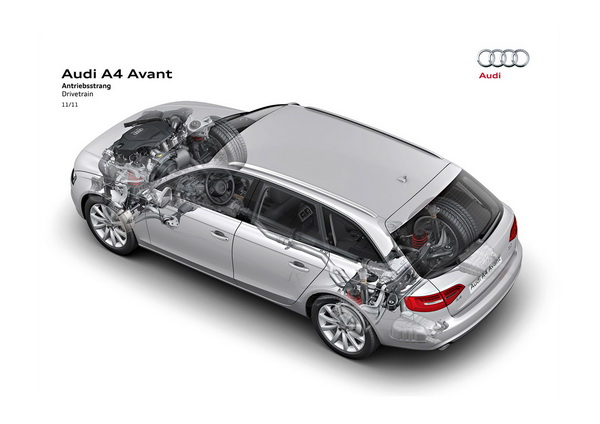 The new Audi A4 – Drivetrain The new Audi A4 – Drivetrain
Audi offers the perfect transmission for every engine version in the A4 family – ranging from a six-speed manual transmission through a continuously variable multitronic to a sporty seven-speed S tronic. 23 engine/transmission combinations are available for the Sedan and the Avant. All transmissions are characterized by high efficiency, precise operation and a wide gear spread. The lower gears feature short, sporty ratios, while the upper gears are long to reduce revs and fuel consumption.
With all transmissions the differential is located in front of the clutch, shifting the front axle far forward. The positive results are a long wheelbase of 2,808 millimeters (9.21 ft) [A4 allroad quattro: 2,805 millimeters (9.2 ft)] and a balanced axle load distribution.
The total weight of the six-speed manual transmission in the updated Audi A4 is low, and the selector fork bearings decouple the shift lever from vibrations. An on-board computer with efficiency program, standard across the entire model family, integrates a gear-change indicator for manual transmissions.
The manual transmissions paired with the four-cylinder engines are integrated into the innovative thermal management system. A heating loop in the heat exchanger ensures that the transmission fluid is quickly brought up to temperature following a cold start. When the engine’s cooling water is hot enough, a portion of it flows to the transmission.
The multitronic is always paired with front-wheel drive in the A4 model series. This continuously variable transmission allows the engine to almost always operate at its optimal efficiency ratio. It offers dynamic drivers a sport program with shorter gear ratios and a manual mode with eight fixed gear ratios. It can also be shifted via the optional paddles on the steering wheel.
Lightning-fast: the seven-speed S tronic
The sportiest transmission in the A4 model series is the seven-speed S tronic, which is always paired with quattro permanent all-wheel drive. At market launch, it will come standard in the 2.0 TFSI quattro, the 3.0 TFSI quattro and the 3.0 TDI quattro with 180 kW (245 hp).
The seven-speed S tronic consists of two sub-transmissions, which are alternately actuated by two clutches. The direct shifts are executed by this dual-clutch transmission; they take just a few hundredths of a second and are so smooth as to be almost imperceptible. The electronic control system offers a fully automatic mode, with two types of operation: D (Drive) and S (Sport). Drivers can shift as they please, including via optional shift paddles on the steering wheel.
Better traction: quattro permanent all-wheel drive
The quattro permanent all-wheel drive system will be available as an option for some models at market launch. It is obligatory in the A4 allroad quattro. The quattro technology operates by purely mechanical means and therefore entirely instantaneously. It represents the ultimate in driving dynamics, traction, driving safety and straight-line stability.
The central component in the quattro drivetrain is the self-locking center differential. Under typical driving conditions, the planetary gear distributes a majority of the engine’s power to the rear for sportiness – 40 percent to the front axle and 60 percent to the rear axle. If one wheel slips, most of the power goes to the other axle. Up to 70 percent can flow to the front wheels and up to 85 percent to the rear wheels.
Audi combines the self-locking center differential with torque vectoring in the updated A4. This intelligent software solution will detect and respond if an inside front wheel is at risk of losing grip while the vehicle corners at a high speed. It brakes the wheel very slightly before this can happen, making handling even more fluid and traction even stronger.
In the 3.0 TDI quattro, 3.0 TFSI quattro and the S models, the quattro drive system can be supplemented with the sport differential, which actively distributes the power to the rear wheels during dynamic driving. This is accomplished by means of superposition gears operated via multi-plate clutches. They rotate roughly ten percent faster than the drive shaft. When the clutch engages, it applies the higher revs to the wheel on the outside of the curve. The additional torque required in order to rotate faster is drawn away from the inside wheel via the differential.
In faster cornering, the sport differential literally pushes the A4 into the radius. The system’s electronic controller is integrated into Audi drive select and can be switched between multiple characteristics. When the sport differential is on board, the torque vectoring function acts only on the front wheels.
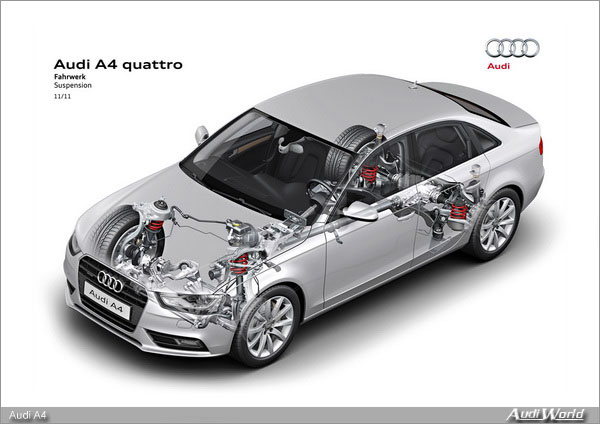
The new Audi A4 – Chassis
The chassis also demonstrates the technological expertise that Audi is investing in the A4 family. All models, from the A4 allroad quattro to the S4, turn spontaneously into corners and remain stable with virtually neutral handling at the very high limit. The composed straight-line tracking and high rolling comfort round out the sporty, balanced impression. The A4 models have a wide track. It measures 1,564 millimeters (5.13 ft) up front in the Sedan and Avant and 1,583 millimeters (5.19 ft) in the allroad quattro. At the rear these figures are 1,551 millimeters (5.09 ft) and 1,574 millimeters (5.16 ft), respectively.
To reduce the unsprung masses, numerous front suspension components are made of aluminum. Audi uses the lightweight material for the integral frame for the engine and axle, which is firmly bolted to the front section of the car for increased rigidity; for the bearing mount that links the upper suspension control arms with the body; for the pivot bearing; and for the five control arms per wheel. The five-link design can handle longitudinal and lateral forces separately. Their bearings are stiff in the lateral direction, fostering sporty precision; on the other hand, the bearings are comfortably pliable in the longitudinal direction. A tubular anti-roll bar also cuts down on weight.
One innovation in the A4 model series is the highly efficient electromechanical power steering, which adapts its boost to the driven speed. The electric motor integrated into the steering gear consumes no energy when driving straight ahead, which depending on the engine lowers fuel consumption by as much as 0.3 liters per 100 km (7 grams CO2 per km [11.27 g/mile]). The concentric arrangement of the steering rack and the servo drive minimizes the dimensions of the steering gear.
The new electromechanical power steering works closely together with the optional Audi active lane assist system. The steering ratio of 15.9:1 is sporty and direct, and the steering gear transfers the input directly to the wheels. Feedback from the road is spontaneous and responsive: traction forces and disruptive forces are practically imperceptible. The Audi A4 has a turning circle of approximately 11.5 meters (37.73 ft).
The rear axle is a track-controlled trapezoidal-link construction that combines low space requirements with excellent driving and comfort qualities. A flexurally and torsionally rigid steel subframe connected to the body via hydraulic bearings constitutes the ultra-strong backbone. Two hollow trapezoidal links, the wheel carriers, the overhead control arms and the tie rods are made of aluminum; a lightweight section serves as an anti-roll bar.
The springs are supported directly by the wheel carriers and are spatially separately from the twin-tube, gas-pressurized shock absorbers to facilitate particularly calibrated response. The shock-absorber tuning and the arrangement of the rear trailing arms are more finely tuned than ever before – which enhances not only the ease but also the sporty precision of handling.
A sport suspension is available as an option for the Sedan and the Avant; it is standard with the Ambition line. Another option is the S line sport suspension, which lowers the body by 30 millimeters (1.18 in). The suspension is also available with adaptive damping control. The CDC (continuous damping control) shock absorbers include electromagnetically actuated valves that control the flow of hydraulic fluid between the shock absorber tubes.
This makes a sporty driving style possible as well as enabling a comfort-oriented configuration, which may be preferred on long highway journeys, for example. The central control unit computes the flow for each shock absorber separately every few milliseconds, taking into consideration the road conditions, the driver’s style and the mode chosen in Audi drive select.
High-end technology: Audi drive select
Audi drive select is one of the high-end features in the A4 model series. In the basic package, it enables the driver to modify the characteristic of the accelerator, the shift points of the automatic transmission and the power steering boost at the push of a button. Additional components can be integrated into the system as options, including the sport differential (for the six-cylinder engines), the damper control, the dynamic steering and the conventional cruise control system or adaptive cruise control.
Audi drive select offers the driver the choice between comfort, auto, dynamic and efficiency modes. The latter mode is new. It also influences the air conditioning and the optional adaptive cruise control or the conventional cruise control system. If the vehicle is equipped with the MMI navigation system, an additional mode, individual, is also included. It allows the driver to specify, within certain limits, their very own profile of preferred settings.
The dynamic steering, which is also electromechanical, uses a superposition gear so that the steering ratio can be varied by nearly 100 percent. Under city-driving conditions, the ratio is very direct; at high speeds, an indirect steering ratio supports smooth straight-line stability. The system supports the driver when cornering at the handling limits, if necessary, reducing both oversteer and understeer by means of load changes.
Elegant: the wheels
The Audi A4 rolls off the production line on elegant wheels. The 1.8 TFSI and 2.0 TDI Attraction with 88 kW (120 hp) have steel wheels; all other variants have alloy wheels. The four-cylinder models in the Attraction and Ambiente trim lines come with 16-inch wheels shod with 225/55-series tires. The sporty Ambition line and the V6 models come standard with 17-inch wheels and 225/50-series tires.
A4 customers can choose from a wide selection of optional wheels. All told there are 18 variants plus another four independent designs for the A4 allroad quattro. Topping the range, which includes four new designs, are exclusive solutions such as the 20-spoke design and the titanium-look, five-arm rotor design. Diameters are as high as 19 inches with 255/35-series tires. The four winter wheels range from 16 to 18 inches in diameter. An indirect tire pressure indicator and a repair kit are standard on all models; a compact spare wheel is optional. Some tires have run-flat properties.
Powerful brakes are located behind the large wheels. Depending on the engine, the discs measure up to 320 millimeters (12.60 in) up front and 300 millimeters (11.81 in) in the back. The two disc halves of the vented front brakes are connected by hundreds of tiny metal cubes for excellent heat dissipation. The brake pads achieve high friction rates.
A4 models with the most powerful engines feature composite brake calipers. The aluminum piston housing dissipates the heat very well. The calipers are lightweight yet extremely rigid; the brake discs and cover plates are also very light. In conjunction with the electromechanical steering, the electronic stabilization program (ESP) aids drivers with braking and countersteering whenever both tires on one side encounter a slippery surface.
ESP with electronic limited slip differential is standard for all front-wheel drive versions of the A4 series. The software solution is active during fast cornering. If the control unit detects that the inside front wheel is at risk of spinning, the control unit will moderately brake that wheel.
The excess torque flows through the differential to the outside wheel, while the difference between the drive forces causes the car to turn very slightly into the corner. The A4 corners precisely, agilely, stably and virtually neutrally.
The Audi A4 allroad quattro features a special technology called Offroad Detection (ORD). This system detects the properties of the surface and adjusts the control characteristic appropriately. The ESP improves propulsion when accelerating on loose surfaces by tolerating more slip.
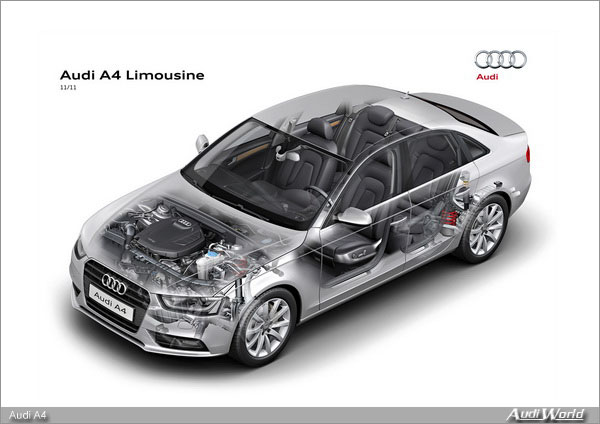 The new Audi A4 – Driver Assistance Systems The new Audi A4 – Driver Assistance Systems
Audi offers an attractive portfolio of assistance systems in the A4 family. Four of them are available as options. The driver information system with break recommendation comes standard in all models with more than 88 kW of power. It can contribute a great deal towards road safety, since about one fourth of all traffic accidents can be attributed to driver fatigue.
The driver information system with break recommendation continuously observes the driver’s steering movements and activation of the gearshift and gas pedal. It thus computes and stores a profile unique to the driver. If the system’s control unit detects that the driver is deviating from their profile – the steering wheel is hardly being used, for instance – visual and audible alarms are triggered. In operation at speeds above 65 km/h (40 mph), the system can be deactivated – like all Audi assistance systems – at any time.
With new capabilities: adaptive cruise control
The adaptive cruise control (ACC) is the most complex of the optional driver assistance systems available in the model family. At speeds between 30 and 200 km/h (18.64 and 124.27 mph), the radar-based system maintains a specified interval between the A4 and the vehicle ahead by accelerating and braking autonomously within certain limits. The driver can switch between four settings to specify the extent to which the system should be comfortable or sporty; following distance can likewise be set to one of four levels.
ACC also features the integrated Audi braking guard. The system warns the driver if the radar sensor of the A4 detects an impending collision with the vehicle ahead. The intensity of the warning varies with the danger of the situation. A gong-like chime and a red signal lamp on the driver information system’s display constitute the first level of warning. At the same time, the brake system is preemptively refilled and the brake pads are positioned close to the discs. If the driver now steps on the pedal, braking is practically instantaneous.
If the driver does not react, however, the second warning level causes the system to briefly brake the vehicle – an attention-grabbing jolt for the driver. If the driver now brakes but does not sufficiently depress the brake pedal, the hydraulic brake assist will boost the braking force as merited by the given situation. If the driver fails to react at all, the system partially brakes on its own to decelerate the A4 by approximately 3 m/s2.
In an emergency at speeds below 30 km/h (18.64 mph), the Audi A4 will apply the brakes with full power – regardless of whether the vehicle ahead is stationary or in motion. At speeds below 20 km/h (12.43 mph), this full braking generally prevents the accident altogether. In other cases, it greatly reduces the impact speed, thus reducing the severity of the accident.
The optional Audi side assist helps the driver when changing lanes. At speeds of 30 km/h (18.64 mph) and above, radar sensors at the rear of the car monitor what goes on behind the A4.
If another vehicle enters the blind spot or rapidly approaches from the rear, a yellow LED indicator in the outside mirror’s housing will light up. If the driver nevertheless activates their turn signal, the indicator will brighten and flash rapidly – it is practically impossible to overlook!
New to the A4 model series is Audi active lane assist, which goes into operation at 65 km/h (40.39 mph). A small video camera in the interior mirror detects the lane markings on the road surface. If the A4 approaches a lane marking without the turn signal having been activated, the system gently intervenes in the new electromechanical steering to coax the driver to remain in their lane. Drivers use the MMI operating system to specify how quickly this assistance system should intervene as well as whether this should be accompanied by vibration of the steering wheel.
Audi offers a choice of three different solutions for easy parking. The top version is the parking system plus with reversing camera. It employs a fisheye lens to film the area behind the car. Images are first corrected by software and then displayed on the MMI monitor; guidance lines and fields help the driver to steer.
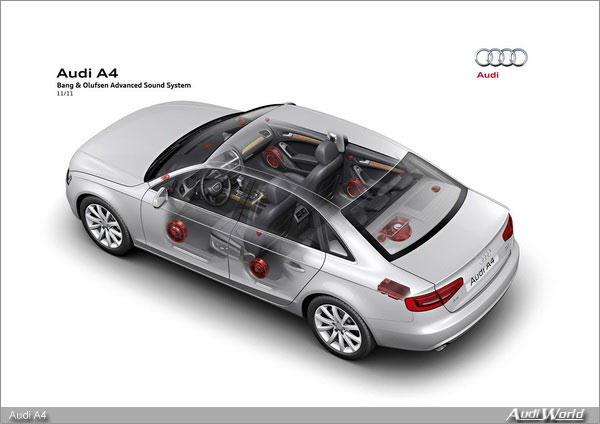 The new Audi A4 – Multimedia Systems The new Audi A4 – Multimedia Systems
A modular system of multimedia components is available for all three body versions in the model line.
The standard chorus radio system features a CD drive and an amplifier that delivers 80 watts to eight speakers. The dual tuner works with two antennas in order to always receive the best signal. The chorus radio is based on Audi’s MMI operating concept and has been paired with a 6.5-inch monochrome display.
The first step up, the concert radio system, also includes an aux-in connection, an SDHC card reader and a 6.5-inch color display. Another alternative is the symphony radio system with a six-CD changer. Above that is MMI navigation. It reads the map data from a DVD; the driver can use voice commands to enter the destination and the system uses dynamic routing to lead the driver there. A triple tuner ensures particularly reliable radio reception.
Powerful media center: MMI navigation plus
MMI navigation plus is the high-end media center in the A4 model series. In addition to the DVD drive, it includes a 60 GB hard drive for navigation, phone and music data. A graphics processor from the specialist NVIDIA generates the three-dimensional images in top quality. The most important buildings of many cities have been lovingly recreated in the richly detailed 3D terrain model that serves as the map.
Measuring seven inches in diagonal and with a high resolution of 800 x 400 pixels, the MMI navigation plus monitor delivers tack-sharp images in brilliant colors. The advanced voice control enables the driver to say the city and street as a single command and also to control the telephone and music playback. In the UK, A4 drivers can also enter destinations using the six- or seven-character postal code – a fast and effective method.
The operation of the MMI navigation plus has also been improved. The number of hard buttons for the main menus has been reduced from eight to four (for Telephone, Navigation, Radio and Media), and the volume control now includes a skip function enabling the user to skip quickly between songs. Cell phones and mobile playback devices can be connected to the system via the Bluetooth interface so that the system can also play back music stored on them.
The Audi sound system is available as an option for all A4 models. At its core is a 180-watt, six-channel amplifier that powers ten speakers, including a subwoofer and a center speaker. The Bang & Olufsen Sound System offers even great sound quality. Its 505-watt, ten-channel amplifier drives 14 high-performance speakers, whose grilles are decorated with aluminum. In conjunction with MMI navigation plus, the system can play back DVDs in 5.1 surround sound.
Other elements complete the infotainment line. These include a dual tuner for digital radio reception (digital audio broadcasting [DAB] as well as DAB+ and DMB Audio), a digital TV tuner, a CD changer in the glove compartment and the Audi music interface as the interface to a mobile playback device or an iPhone.
Options for convenient telephony include a Bluetooth interface that also allows playback of music stored on the phone in the car and a Bluetooth cell phone preparation with a hands-free unit and voice control.
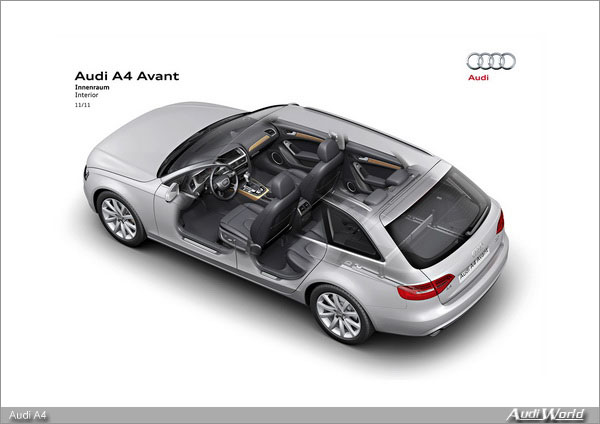 The new Audi A4 – Audi Connect The new Audi A4 – Audi Connect
The keyword Audi connect refers to the networking of Audi cars with their surroundings. Among the high-end options available in the updated A4 family is the Bluetooth online car phone that uses a UMTS module to connect to the Internet.
The UMTS module integrated into the MMI navigation plus system offers a number of attractive services. It delivers specially prepared, easy-to-read news, travel and weather information plus points of interest from Google to the vehicle. Drivers can plan their routes on their home computers, upload them to a special section of the Internet site www.audi.com and download them from there to the car upon starting the trip. The map can also be underlaid with aerial and satellite images from Google Earth for an extremely attractive look, if desired.
Another feature of the system, the WLAN hotspot, enables passengers to connect up to eight mobile devices – from iPhones to laptops – to the Bluetooth online car phone so that they can surf the Web and send e-mails. Audi offers an optional handset for discreet phone calls.
The Bluetooth online car phone is operated either via the MMI navigation plus terminal, using the multifunction steering wheel or by voice control. Signals are encrypted according to the WPA2 standard and broadcast via the roof-mounted antenna. If the A4 is traveling outside the UMTS network, the system switches to the EDGE standard.
To go online, drivers merely need to insert a data-capable SIM card into the card reader to go online. Alternatively, they can connect their cell phone to the system via Bluetooth if it is equipped with the necessary SIM Access Profile. No additional fees or separate contracts are required. Given the high data volumes, however, Audi does recommend an appropriate flat rate.
Quality information: Audi online traffic information
The Bluetooth online car phone brings another high-end service on board the Audi A4 – Audi online traffic information. The service displays traffic flow data on the navigation map. If the route chosen by the driver is free, it appears in green on the monitor. Yellow indicates dense traffic, orange represents slow-moving traffic and red denotes standing traffic. In this case, Audi online traffic information reports the hold-up in a text and suggests an alternate route that does not lead directly to the next traffic jam.
Because it takes rural routes and cities into consideration, the system is faster, more precise and more intelligent than conventional TMC and TMC Pro solutions. It gets its data primarily from the hundreds of thousands of smartphones and navigation devices being carried in cars and reporting their current positions in short intervals through the mobile phone network to a service provider. The data are analyzed to provide a nuanced portrayal of traffic flows.
Audi online traffic information recently debuted in Central Europe, France, the UK and Italy; additional countries will soon follow.
Another new connect service offered through the Bluetooth online car phone is the Google POI search, which in this case is voice-controlled. The driver need merely select a destination city and say the desired key term or phrase – such as “Italian restaurant.” The voice command, or “voice tag,” is converted into a data packet and sent to the Google search engine. The responses appearing on the onboard monitor are highly differentiated – they frequently contain the phone numbers of the restaurants and various additional information.
A third groundbreaking connect function is also available in the A4: Google Street View shows the selected destination as it appears from the car before you arrive, making it much easier to get your bearings when you do.
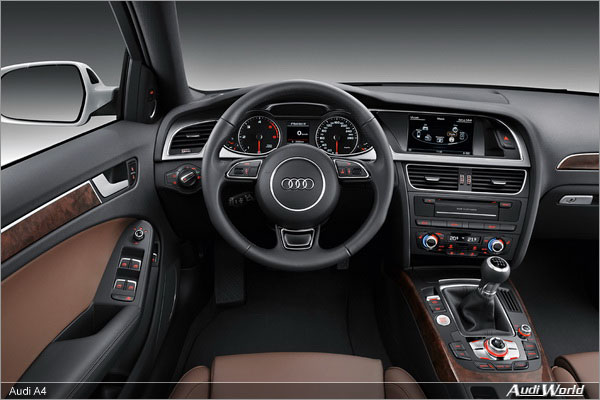 The new Audi A4 – Equipment The new Audi A4 – Equipment
The A4 is offered in three trim lines on the German market: Attraction, Ambition and Ambiente. Even Attraction comes with a generous array of standard equipment, including an automatic air conditioning system, the chorus radio system and the 6.5-inch monochrome monitor. Other standard features include the electromechanical parking brake, daytime running lights, front fog lights, power windows, remote-controlled central locking system and power-adjustable and heated exterior mirrors with LED turn signals in the housings.
The Ambition line underscores the sporty personality of the A4. It includes such things as 17-inch alloy wheels even with four-cylinder models, sport seats, a sport suspension, a three-spoke leather sport steering wheel and the driver information system. The luxurious Ambiente trim line comprises heated seats and a center armrest up front, a four-spoke leather multifunction steering wheel, cruise control, rear parking aid, the high-gloss package and the lighting package.
There is also a wide range of options. Besides the features already mentioned, the convenience key is also worthy of note. It can stay in the jacket pocket – the doors are opened by radio and the car is started by pushing a button. Audi hold assist makes using the electromechanical parking brake on hills even more convenient by maintaining the brake pressure. The high-beam assistant switches automatically between the low and high beams.
The A4’s interior can be made even more luxurious by optional equipment such as the auxiliary heater, garage-door opener, electrically folding exterior mirrors, automatically dimming interior mirror, alarm system, cruise control system, light and rain sensors and the lighting package. Audi offers a glass sunroof, a large, two-piece panoramic sunroof and dark privacy glazing for all three body variants. There is also a power rear window shade for the sedan.
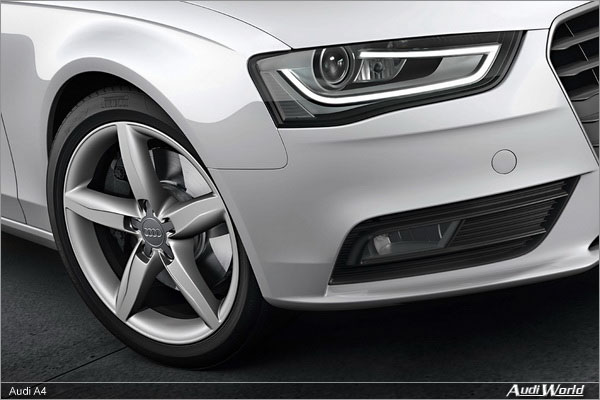 The new Audi A4 – Pricing and market The new Audi A4 – Pricing and market
Despite the extensive product improvement, Audi is raising prices of the A4 models only very moderately. For example, the Audi A4 1.8 TFSI with 88 kW (120 hp) costs just €27,500.
The Audi A4 appeals to a customer group that is significantly younger than the clientele of its primary competitors. The most important reason for buying cited by European A4 customers is the design, particularly with the Avant. The quality is also a very important factor with all of the models.
Mid-size models have been the heart of the Audi brand for 39 years. Four generations of the Audi 80 rolled off the assembly lines between 1972 and 1994/95, before it was replaced by the A4. This is now also the fourth generation of the A4. The brand recently celebrated a major production milestone: The ten-millionth mid-size car produced by Audi since 1972, a Misano Red S4, rolled off the assembly line in mid-October.
The A4 model series with all of its derivatives has also been a big seller and has served as the platform for key innovations. Some of the developments with which Audi has demonstrated its Vorsprung durch Technik include quattro drive with self-locking center differential, the fully galvanized body, the four-cylinder TDI, the S tronic and the sport differential.
|

